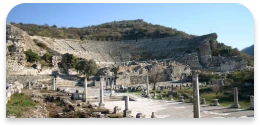Temple of Artemis

The Temple of Artemis is known as one of the Seven Wonders of the ancient world. It has been built in the areas of Ephesus on a flat area which has over the centuries turned into a swamp. If you visit Ephesus today, you can only see the ruins of the foundations of this marvelous construction of the Hellenistic Age, entirely made of marble and full of sculptured columns' capitals and shafts. The most beautiful remaining of this temple are today exhibited in the London British Museum.
The oldest remaining found date back till the 6th century BC. It was surrounded by 36 huge columns, later enlarged upon the orders of the Lydia King, Kreisos, during the 6th century BC. Most of the exhibits in the London British Museum belong to this period.
The new Artemis has been rebuilt in the 2nd century BC. Located on top of the previous one, it had tremendous dimensions: 127 columns of each 17,5 meters high. Unfortunately this one has also been destroyed by fire, reconstructed and again demolished by earthquakes, rebuilt and at last looted by Goths one year later.
The statue of many-breasted Artemis was the symbol of the temple but also of abundance, hunting and wild life.
The genuine statue of Artemis, removed during the fire, is today exhibited in the Ephesus Museum. Many copies of this statue found during the latest excavations date back from the Roman period.
Find the best Artemis Tour from Kusadasi
Mythological Info
Artemis was also called Cynthia, from her birth place, Mount Cynthus in Delos. She was Apollo's twin sister, daughter of Zeus and Leto. She was one of the three maiden goddesses of Olympus: the pure maiden Vesta, gray-eyed Athena who cares but for war and the arts of the craftsmen, and Artemis, lover of woods and the wild chase over the mountain.
She was the Lady of Wild Things, Huntsman-in-chief to the gods, an odd office for a woman. As a huntress her favorite animal was the stag, because its swiftness gave the best opportunity for her method of capture, which was by her silver bow and arrows and speed of foot.
As Phoebus was the Sun, she was the Moon called Phoebe and Selene (Luna) representing the evening and night, carrying a torch, and clad in long heavy robes, with a veil covering the back of her head. Neither name originally belonged to her.
Phoebe was a Titan, one of the older gods. So too was Selene, a moon-goddess, indeed, but not connected with Apollo. She was the sister of Helios, the sun-god with whom Apollo was confused.
She was worshiped in Athens, Corinth, and Thebes as goddess of strict upbringing, of good fame, of upright mind, and of sensibility in the affairs of ordinary life. She chased and fired her arrows at all wild and unchecked creatures and actions.
In the later poets, Artemis is identified with Hecate. She is "the goddess with three forms", Selene in the sky, Artemis on earth, Hecate in the lower world and in the world above when it is wrapped in darkness. Hecate was the Goddess of the dark of the Moon, the black nights when the moon is hidden. She was associated with deeds of darkness, the Goddess of the Crossways, which were held to be ghostly places of evil magic.

Footnotes:
At Ephesus, where her great temple was one of the seven wonders of the world, Artemis was represented with a mural crown, with a disc behind the crown; on her breast, a garland of flowers, as a sign of her influence in spring time. Lions cling to her arms; as mother of wild beasts, she has many breasts; her legs are closely bandaged and ornamented with figures of bulls, stags, lions, and griffins; at the sides are flowers and bees. This figures may have resembled the original image of the goddess which had fallen from heaven.
Selene, (Luna) is represented as riding on a mule or a horse; on the pediment of the Parthenon it is a horse.
















